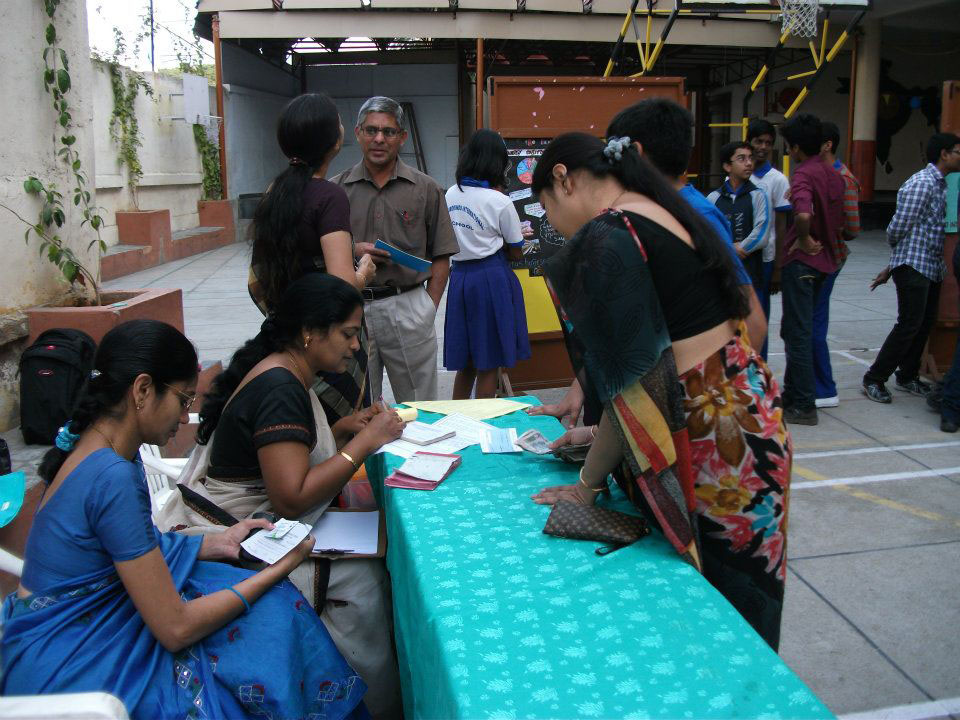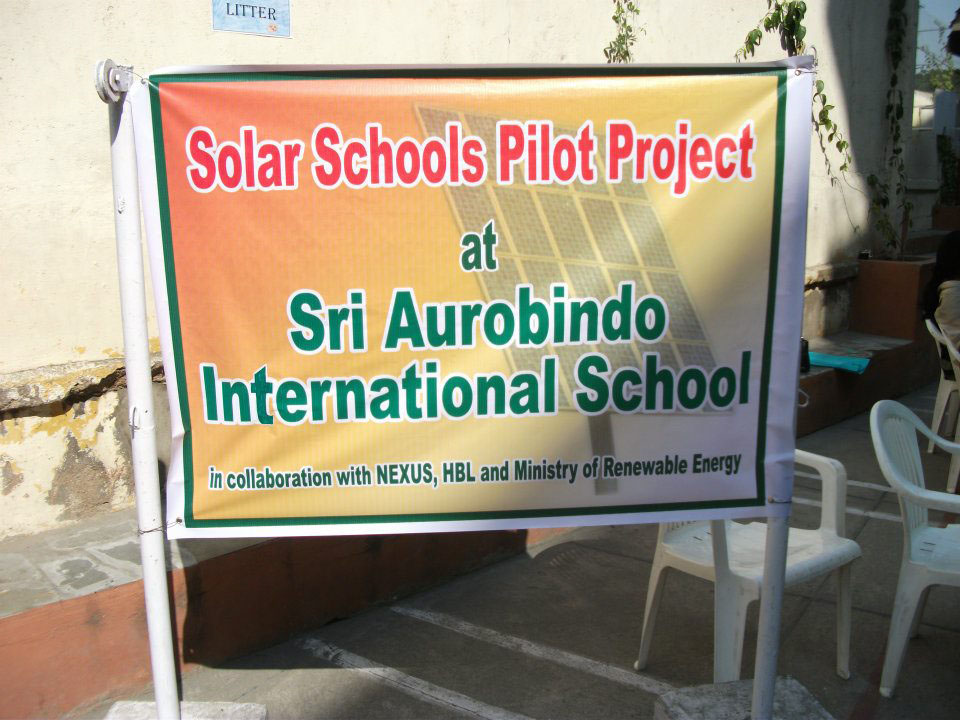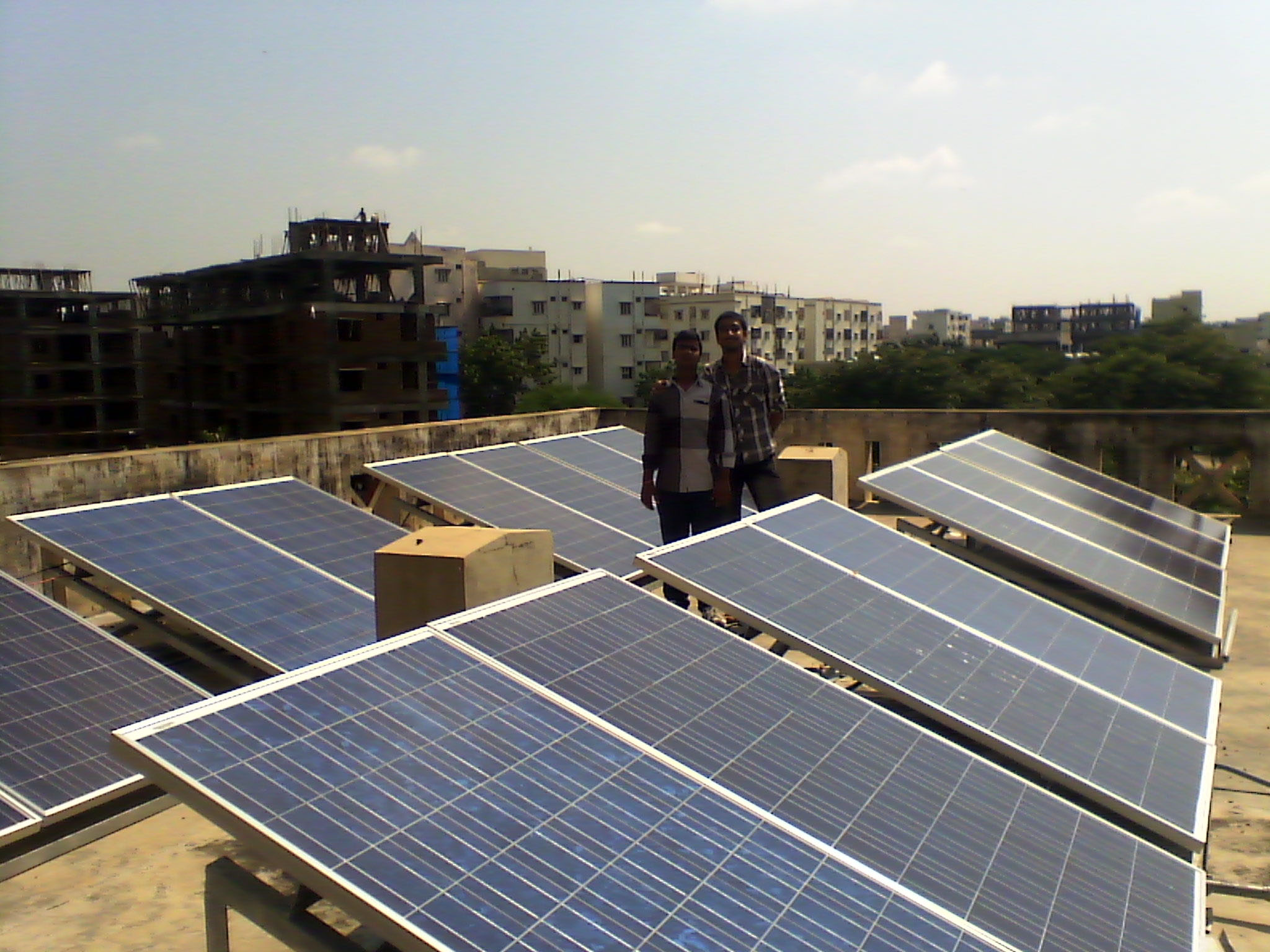 Solar powered schools, Hyderabad, India - © Steinbeis India
Solar powered schools, Hyderabad, India - © Steinbeis India Fund raising at Sri Aurobindo School - © Steinbeis India
Fund raising at Sri Aurobindo School - © Steinbeis India- Inauguration Ceremony October 2012 - © Steinbeis India
- Solar Powered Schools, Hyderabad, India - © Steinbeis India
 Sign indicating Solar School - © Steinbeis India
Sign indicating Solar School - © Steinbeis India Solar panels in Anji Reddy School rooftop - © Steinbeis India
Solar panels in Anji Reddy School rooftop - © Steinbeis India- Sri Aurobindo International School - © Solar powered school project
City
Hyderabad
Main actors
Supranational / Intergovernmental Institutions, Private Sector, Community / Citizen Group, Research Institutes / Universities
Project area
Whole City/Administrative Region
Duration
2009 - 2013
The project aims at low-carbon power supply for public buildings and their neighbourhoods.
Hyderabad has an increasing rate of urbanization and economic growth and one of the main challenges is to provide a sustainable model for energy supply. Blackouts are common and local schools are impacted as learning conditions are negatively affected.
The SOLAR POWERED SCHOOLS PILOT-PROJECT, was initiated as one of the outcomes of the Indo-German research project “Sustainable Hyderabad”, it follows an interdisciplinary and demand-driven approach. The project aims at encouraging climate-friendly neighbourhoods and sustainable lifestyles through the use of clean energy sources, for example, the sun. Local Schools in Hyderabad have been raising funds and installing solar panels on their rooftops both as an educational effort and to address their energy needs.
Why become a Solar School ?
-
Future generations learn how to contribute to a climate-friendly, sustainable city development.
-
Activities and fundraising of the children involve the local community in shaping their future energy consumption patterns.
-
Since solar energy is still highly expensive to most Indian households, the demonstration project could exemplify the possibilities and the advantages of this renewable source of energy.
-
Learn more about the quality of stand-alone rooftop systems and support the local (solar) industry.
-
Find new ways to set incentives for a broad implementation of small scale projects by improved governance structures and increased efficiency of institutions.
Hyderabad’s demand for energy continues to increase rapidly, however, the energy supply is neither reliable nor sufficient. The power deficit in the former state of Andhra Pradesh for the year 2011-2012 that has been estimated by the Central Electricity Authority of India at 12.1%. Furthermore, with the growth of the city and the increasing consumption of conventional electricity, the emission of greenhouse gases has increased. In schools, blackouts are a common occurance and both students and teachers suffer. A blackout negatively influences the learning conditions as key devices relevant for a positive learning atmosphere (e.g. computer labs and lighting) cannot be used. The schools are dependent on conventional energy from their supplier and are not able to cope with electricity cuts and the adverse environmental effects.
Installing rooftop photovoltaic (PV) systems on schools can ensure an independent energy supply, which is especially important in case of blackouts. The generated electric energy is used efficiently in the schools. Furthermore, installing a PV system on schools raises the awareness of climate and energy efficiency. As the photovoltaic technology uses the sun radiation as a renewable energy source, it has a small carbon footprint and reduces CO2 emissions for producing energy.
Another objective is to build a reliable network which enables a policy environment not just for facilitating private adoption of roof top solar photovoltaic at the state level, but for further incentivizing its usage, particularly for the social sector. This requires networking between decision makers, administrative bodies and governmental agencies responsible for the implementation of Jawaharlal Nehru National Solar Mission (JNNSM).
From an economic perspective, the aim is to create a favorable environment for investments on a small scale market and generate additional business opportunities for private stakeholders involved. Local as well as national or international enterprises active in the field of renewable energy technology can benefit from rising energy deficit, but also from rising demand.
The main project partners for Solar powered Schools are
- nexus Institute for Cooperation and Interdisciplinary Research (nexus),
- Steinbeis Centre for Technology Transfer India (SCTI),
- Division of Resource Economics in the Department of Agricultural Economics at Humboldt University Berlin (RESS),
- Solar company Granzör Engineering Pvt. Ltd.
There is also a wider circle of private and public stakeholders who support the project in various ways. The implementation took place in three schools in Hyderabad:
- Sri Aurobindo International School (SAIS),
- Kallam Anji Reddy Vidyalaya (Dr. Reddy’s Foundation), and
- Meridian School, Madhapur.
The administration of Solar powered Schools is divided into major areas which can be dealt with separately. This is done by developing a Memorandum of Understanding between all project partners wherein their main responsibilities are defined.
Different spheres of work are:
(1) The overall coordination of the project in Germany and India, which includes the communication of progress and results.
(2) Promoting the project and identifying suitable partner schools in combination with supporting the schools in fund-raising.
(3) The development of awareness building measures for the schools and other interested stakeholders.
(4) Nominating a local partner in India who coordinates, supervises and evaluates the local implementation and success of the project. The nominated partner should also facilitate the cooperation with local project partners.
(5) Developping a sustainable and attractive business plan and supervising the financial viability of the project .
(6) To implement the project, a partner prepares the budget in order to apply for funding and carries out the technical realization, namely engineering procurement, construction and maintenance.
(7) For the future development and sustainability of the project, up-scaling possibilities have to be evaluated and implemented.
(8) Media and public relations are an essential factor for the self-sustaining aspect of the project. I
Planning Process
The implementation and practical output of the project are broadly divided to five areas : institutional setting, economics, technical, environmental, social and educational . First of all it is important to evaluate the energy consumption of the school and to create an overview of where and how much this energy is consumed in the school area. In this context ,all options for energy saving and energy efficiency should be explored.
In consistency with the status-quo analysis and the financial capabilities, the dimensions of a suitable photovoltaic system is calculated. Furthermore an appropriate area for the photovoltaic system has to be found. The size of the available area has to be included into the calculations. The most suitable location is a roof top with southern orientation and no shading from trees or other building parts. The shading is a crucial factor, because the total capacity produced depends on the weakest (shaded) module connected in series. While evaluating different offers from solar corporations a detailed expense allocation and technical specification of all key devices and services has to be provided. This contains among other the solar modules, inverter, energy meter, grid connection or battery and also the required working time. A crucial quality measure is the Performance Ratio (PR) or fill factor of a photovoltaic system. The PR describes the effectiveness of the whole system as a ratio between the maximum obtainable power and the actual open circuit voltage. This measure should be superior to 70%. Test certificates from the government or an independent inspection authority give information about the quality and reliability of the products.
Installation and monitoring
The installation is performed by a qualified installer or electrician. Nevertheless, observing the installation process is a worthwhile investment as arising questions can be answered right away and the students and teachers get a first impression of how a photovoltaic system works in practice. After the installation is completed, a commissioning certificate and documentation of the inspection results of all devices is handed over. This project period is also well-suited to strengthen public relations work by informing the students, teachers, parents and interested neighbouring people, in order to increase their acceptance and involvement in the project.
After the installation is successfully completed, the photovoltaic system produces electricity whenever solar radiation reaches its surface. However it is important to regularly meter and control central variables of the photovoltaic system to ensure an efficient and smooth operation. This can be done manually by regularly reading the power production displayed on the inverter. Nevertheless, controlling and editing the important PV system variables is a sophisticated and time-consuming job. Furthermore the metered data is not visible and usable for a wide range of people.
A solution would be the installation of a data logger combined with a display board and a web portal. Installing a data logger simplifies the monitoring of the PV system and the detection of potential failures. With the help of a data logger all relevant variables are metered and saved regularly. Moreover a previously adjusted and installed warn message makes it easier to quickly find and correct defects within the system.
A data logger can be installed at different positions in the photovoltaic system:
- Readout directly at the inverter
- Implementing a energy meter between data logger and inverter; Readout at the S0 pulse output
- Metering directly on the power cable via shunt resistors
Metering the important PV system variables:
- DC/AC current, voltages and power generated
- Performance
- Possible failures within the system
Another advantage of a data logger is that the metered data can be processed right away. The regularly metered and saved data can be accessed directly via memory card, which is plugged in the data logger or sent to a defined server via DSL/Ethernet or GSM. Using a free already configured web portal, all data is automatically send there, archived, edited and visualized. The web portal allows to monitor the PV system thoroughly, regularly and effort-saving.
The acquisition costs for a photovoltaic system are high and need to be based on a sustainable finance plan. In this context it is important to engage with the different possibilities of governmental subsidies. The Government of India, namely the Ministry of New and Renewable Energy (MNRE) has embarked on the Jawaharlal Nehru National Solar Mission to encourage the growth of the renewable energy sector. The financial evaluation of the project has been analysed for both on-grid and off-grid systems in the respective schools. Still, as a Feed-in-Tariff (FIT) was not available, the focus has been on off-grid (stand-alone) systems. During the pilot project phase, a MNRE subsidy of 30% of the installation costs has been available.
Nevertheless, support programmes mostlycover a part of the project expenses and hence other options of creating a sustainable financial model have to be found. An effective public relations campagin work with a positive image of solar energy for schools provides excellent conditions for public or private sponsoring. After amortizing, the school saves money as the electricity bill has become very low and can think about up-scaling the project or using the money for social causes.
The technical realisation of PV systems has been successfully completed at three local schools. The implementation process was evaluated and accompanied by capacity building measures. Moreover, options for feasible financing without Feed-In-Tariffs (FIT) were evaluated and documented. The schools today use the new decentralised energy supply to cover blackouts, which immediately results in better learning conditions. Additionally, they have become more independent from conventional energy suppliers. The response to the pilot project was extremely positive, a first impulse was set by the pilot project to implement change and contribute to the improvement of governmental structures and efficiency of institutions, which encourage the expansion of renewable energies. Many other schools in Hyderabad have shown a willingness to adopt solar energy and it is believed by the project team, that small-scale rooftop solar systems will be widely adopted, if the technical and financial viability illustrated by the pilot project is further mobilised to raise social awareness and along with it the state initiates systematic long term policy instruments.
A significant result of the project is the growing awareness of renewable energy technologies and sustainable lifestyles against the background of climate change. The long-term monitoring of renewable technology should encourage teachers and students to participate in the maintenance of the PV system.
Associating the pilot project with research, provided the opportunity to clearly detect and understand the different challenges the schools faced in the course of implementation. The long-term growth of the sector will require mobilisation of such success cases and systematic long term government support.
The current subsidies from the central government are not conducive for long term growth as the financial incentives are limited to an unknown number of projects with no certainty of the future incentive structure. Long-term growth of the sector will require a well-structured incentive structure that takes into account not only the viability of the project but also considers the financial burden to the public from the higher solar tariff.
Apart from the much needed long term financial incentives, experiences from the project also indicate a high level of transaction cost in the overall project implementation process due to the emerging nature of the industry and lack of experience from market participants. There is a huge role and scope for public authorities to facilitate in this regards. Public agencies, such as the state nodal agencies for renewable energy development, can play a central role in raising public awareness and facilitate the interaction amongst early adopters, financiers and project developers. To enable such a process, the renewable development agencies in the city can provide a one-stop-agency service which advises potential developers on project financing, product quality and existing project developers.
Additionally, social and cultural factors, such as awareness for environmental concerns in the public and private sphere are essential as only then will the community engage in the production of renewable energy. And only then will the energy consumer be prepared to bear possible higher costs for the initial investment through direct or indirect financial support. Both those propositions were met in the described case.
This case study has shown that small-scale solar energy can contribute to clean energy production in cities. This is especially true in emerging megacities, where the accelerated growth results in a gap between energy provision and demand. Here, decentralized energy production with renewables can support the sustainable development. This requires, however, certain propositions to be met. First of all, solar energy is only an option in countries and cities that have a respective solar radiation so that an investment is sustainable in the economic sense. Also, social or cultural factors, like awareness for environmental concerns in the public and private sphere are essential, since only then the civil society engages in the production of renewable energy. And only then, the energy consumer is prepared to bear possible additional costs from e.g. subsidies. Nevertheless, the study has also shown how important it is to consider the institutional framework. Institutional factors need to be throughout analysed and taken into account for successful implementation of energy production projects.
Important aspects of knowledge-transfer:
-
A network among project schools has been build up to strengthen their ability to deal with future challenges in order to self-sustain the project and to continue exchange of experiences: “Education for Sustainable Lifestyles: Participative learning about sustainability and life-cycle thinking”.
-
Internal workshops on solar energy for students, school staff, parents, citizens informed about PV technology, raised awareness for sustainable energy consumption and environmental issues. Awareness raising has encouraged teachers and students in the maintenance of the PV systems.
-
The topic of renewable energy, including solar power, its performance and benefits, has been permanently included into the extracurricular school activities to make the success visible for the public and to encourage participation.
-
Since FITs not yet available, there is a need for feasible financial models that can serve as fundamental guidelines for other institutions. However, first drafts for a sustainable business plan for PV systems at schools have been evaluated and documented as broad guidelines for interested institutions.
-
Decentralised renewable energy solutions accompanied by capacity building activities improved local living conditions and should thus be continued to be implemented to forward sustainable lifestyles.
-
CERC 2012: Central Electricity Regulatory Commission: National Electricity Plan, Vol.1: http://www.cercind.gov.in, accessed March 05, 2010.
-
Fraiers, A., Neame, C., Cook, M., 2007: The adoption of domestic solar-power systems: Do consumers assess product attributes in a stepwise process: Energy Policy, 35, 6, 3418–3423.
-
Hagedorn, K., Arzt, K., Peters, U., 2002: Institutional arrangements for environmental co- operatives: a conceptual framework. In Hagedorn, K. (ed.), Environmental Co-operationand Institutional Change: Theories and Policies for European Agriculture. Cheltenham, UK: Edward Elgar. (2002): 3–25.
-
Harriss-White, B., Rohra, S., Singh, N., 2010: Political Architecture of India’s Technology System for Solar Energy: Economic & Political Weekly, 44(7), 49-60.
-
Horam, Phungmayo/ Angela Jain/ Christine Werthmann (2013) Solar powered Schools for Hyderabad/ India - An attempt for decentralized energy production. In: Ludger Eltrop, Thomas Telsnig, Ulrich Fahl (Ed.) Energy and Sun - Sustainable Energy Solutions for Future Megacities. Jovis, 73-85
-
National Electricity Policy, 2005: National Electricity Policy. The Gazette of India:http://www.powermin.nic.in/whats_new/national_electricity_policy.htm, accessed January 23, 2010.
-
Jaswal, A.K., 2009: Sunshine duration climatology and trends in association with other climatic factors over India for 1970-2006: Mausam, 60, 437–54.
-
JNNSM 2009: Jawaharlal National Solar Mission: National Solar Plan- Govt. of India_Final Draft: http://www.indiaenvironmentportal.org.in/files/national-solar-plan.pdf,accessed January 23, 2010.
-
Kulkarni, A., 2011: Report on barriers for solar power development in India. South Asia
-
Energy Unit, Sustainable Development Department, The World Bank: http://www.esmap.org/sites/esmap.org/files/The%20World%20Bank_Barriers%20for%20Solar%20Power%20Development%20in%20India%20Report_FINAL.pdf, accessed January 20, 2011.
-
Michalena, E., Angeon, V., 2009: Local challenges in the promotion of renewable energy resources: The case of Crete: Energy policy, 37, 2018–2026.
-
MNRE 2010d: Ministry of New and Renewable Energy: Guide lines for off-grid projects: http://www.mnre.gov.in/adm-approvals/aa-jnnsm-2010-11.pdf, accessed January 20, 2011.
-
MNRE 2008b: Guide lines for generation based incentives (GBI) — grid inter-active solar power PV generation projects: http://www.mnre.gov.in, accessed October 21, 2012.
-
NAPCC 2008: National Action Plan for Climate Change: National Action Plan for Climate Change, Prime Ministers Council on Climate Change: http://pmindia.gov.in/climate_change_english.pdf, accessed July 23, 2009.
-
Nexus, 2010: Participative Energy Management – socio technical experiments for low emission lifestyles. Sustainable Hyderabad, WP6, paper 1B, Status Report, 08/2010.
-
NREL 2011: National Renewable Energy Lab: India Solar Resource: http://environmental.design.files.wordpress.com/2011/01/dni_annual.jpg, accessed December 10, 2011.
-
NREL 2012b: National Renewable Energy Lab: Solar Schools Assessment and Implementation Project: Financing Options for Solar Installations on K–12 Schools. (http://www.nrel.gov/docs/fy12osti/51815.pdf, accessed October 11, 2012)
-
Perez, Y., Ramos-Real, F. J., 2009: The public promotion of renewable energies sources in the electricity industry from the Transaction Costs perspective. The Spanish case: Renewable and Sustainable Energy Reviews, 13,1058–1066.
-
Purohit, P., Michaelowa, A., 2008: CDM potential of solar water heating systems in India: Solar Energy, 82, 799–811.
-
Singh, R,. Sood, Y.R., 2011: Current status and analysis of renewable promotional policies in Indian restructured power sector – a review: Renew Sustain Energy Review,15, 657–64.
-
Solangi, K.H., Islam, M.R., Saidur, R., Rahim, N.A., Fayaz, H., 2011: A review on global solar energy policy: Renewable and Sustainable Energy Reviews, 15,4, 2149–2163.
-
Spreitzhofer, G., 2006: Megacities: Zwischen (Sub)urbanisierung und Globalisierung. (Megacities: Between (sub-) urbanization and globalization): Friedrich Ebert Stiftung, Online Akademie 2006: http://library.fes.de/pdf-files/akademie/online/50340.pdf, accessed April 20, 2010.
-
Steg, L., Vlek, C., 2008: Encouraging pro-environmental behaviour: An integrative review and research agenda: Journal of Environmental Psychology, 29,3, 309-317.
-
Tariff policy, 2006: TARIFF POLICY, The Gazette of India: http://www.powermin. nic.in/whats_new/pdf/Tariff_Policy.pdf, accessed January 23, 2010.
-
The Electricity Act, 2003: THE ELECTRICITY ACT, 2003: http://powermin.nic.in/ acts_notification/electricity_act2003/pdf/The%20Electricity%20Act_2003.pdf, 2003, accessed January 23, 2010.
-
Trivedi, B. 2011: Solar Power Becomes Cheaper than Diesel in India: http://www. renewableenergyworld.com/rea/news/article/2011/12/solar-power-becomes-cheaper-than-diesel-in-india, accessed December 13, 2011.
-
Unabhängiges Institut für Umweltfragen e.V. (2011): Zwischenbericht „Solar Support“ 1-3. http://www.ufu.de/de/solarsupport/solarsupport-fuer-schulen.html, accessed July 14, 2011
On Map
The Map will be displayed after accepting cookie policy







